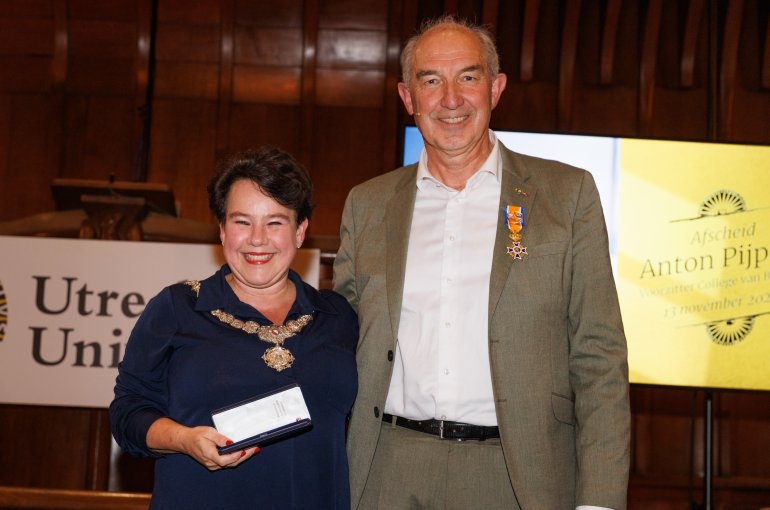Rocket impact exercise scenario for Emergency Hospital

During its annual exercise, the Calamity Hospital simulated a rocket attack to strengthen cooperation between civilian and military healthcare teams.
A missile strike? In the Netherlands? Does healthcare in the Netherlands really need to prepare for that? Yes, says Chairman of the Board of the UMC Utrecht Carina Hilders. “Given the tense situation in the world, we take all scenarios into account when preparing to care for victims.” So on Nov. 1, the annual exercise at the Emergency Hospital was dominated by armed international conflict. “Let’s hope it never gets that far. But if it has to, we are here ready to take care of the wounded. Civilian and military.”
Emergency hospital is operational within thirty minutes
The Emergency Hospital is a special hospital. It is a collaboration of the Ministry of Defense, the UMC Utrecht and the Ministry of Health, Welfare and Sport. The Calamity Hospital must always be operational within thirty minutes and be able to receive large numbers of victims. Volunteers from the Red Cross provide support in this regard. That is why there is a large exercise every year, in which dozens of victim actors are transported to the Calamity Hospital.
Rik Bergman, commander of the Central Military Hospital: “Resilient care requires more than good equipment and skilled professionals. It requires close cooperation between civilian and military healthcare organizations, in which we know how to find each other blindfolded when it matters. The Emergency Hospital is resilient care in practice. But preparedness requires maintenance – that’s why we practice, today and tomorrow.”
The annual exercise was attended by, among others, Minister of Health, Welfare and Sport Jan Anthonie Bruijn and Utrecht Mayor Sharon Dijksma. “I found it impressive to see how everyone interacted with each other and how smoothly the reception of the wounded went,” says Dijksma.”A reassuring feeling as a resident of the Netherlands.As mayor of Utrecht, I am proud that we are resilient in crisis situations and can provide care quickly.”
The victim actors are all given their own scenario, ranging from mildly injured to life-threatening. There are also patients with pre-existing conditions, such as deafness, sickle cell disease or who have had a sexually traumatic experience. It is up to the caregivers to figure everything out and amid the constant flow of patients to give each individual the proper care.
For trauma physician Dominique Buck, it was the first time she had final medical responsibility during the annual exercise. “As a trauma doctor, I have been through many exercises, and it is always instructive. In this exercise, I saw once again how good civil-military cooperation can be and how much we can benefit from each other.”
Not only healthcare personnel practice, but entire crisis organization
The exercise is not only for healthcare personnel, the entire crisis organization of UMC Utrecht is training along with them. For example, a full team of social workers, clinical psychologists and Red Cross volunteers were also on hand for kinship care. The Facility Management Department also practiced scaling up security and the telephone system, among other things, and the Marketing and Communications Department was also active. Salient detail: because of the advice to boil the drinking water, the crisis organization was actually in operation in parallel.
Facts and figures
A total of 169 victim actors participated, some of whom performed several times as patients. Some also participated as relatives of victims. From the UMC Utrecht about 300 colleagues practiced, from the defense 11 health care providers, 35 students of the Defensity College and 56 employees of the Red Cross. To ensure the exercise ran smoothly, a team of about 56 observers, prompter and opposing players also participated.

Utrecht Science Park start-up Beephonix grows with the help of student workers
Utrecht Science Park start-up Beephonix is growing with support from student workers via Topselect, using its patented microphone technology for hearing implants and drone detection.

Royal honour awarded to Anton Pijpers at his farewell
At his farewell, Anton Pijpers was appointed Officer in the Order of Orange-Nassau and received multiple distinctions recognizing his exceptional contributions to Utrecht University and the region.

In the media: Utrecht Science Park as a ‘powerhouse’ of the biotech sector
Following the proposed merger of Utrecht Science Park companies Genmab and Merus, several media outlets have published articles highlighting the strength of the Utrecht Science Park ecosystem. For example, the Financieele Dagblad discussed the “biotech powerhouse” and the importance of growth opportunities to ensure this knowledge remains in the Netherlands.

Utrecht Science Week anniversary edition a great success
The fifth edition of Utrecht Science Week was a resounding success! With more programs, locations, speakers, and visitors than ever before, we look back on an exciting week. The variety of programs and the diverse audience were wonderful to witness. This way, the groundbreaking research here at Utrecht Science Park isn’t kept behind closed doors, but is given the opportunity to inspire others.